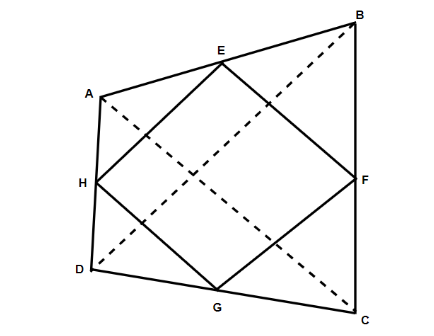
$ ABCD $ is a quadrilateral with unequal sides, unequal diagonals, and unequal angles. $ E,F,G,H $ are the middle points of the four sides, then $ EFGH $ is a:
$ \left( a \right){\text{ Quadrilateral with unequal sides}} $
$ \left( b \right){\text{ Parallelogram}} $
$ \left( c \right){\text{ Rhombus}} $
$ \left( d \right){\text{ Rectangle}} $
Answer
459.3k+ views
Hint: For solving this, we will first make the figure. And then taking the triangles made in then and comparing the lines we will get the lines are getting parallel to each other. And by using this we will conclude to answer this question.
Complete step-by-step answer:
Since it is given that the $ ABCD $ is a quadrilateral with unequal sides and $ E,F,G,H $ are the middle points of the four sides. So on joining the diagonals of the quadrilateral which will be named as $ BD $ and $ AC $ .

Now we will take a triangle $ ABD $ , for the reference we take it from the figure. So in this triangle $ H $ and $ E $ will be the midpoints of the sides $ AD $ and $ AB $ respectively.
Hence, from this we have $ HE||BD $ .
Similarly, we will take a triangle $ BCD $ , in this triangle $ FG||BD $ and in the same way we will get $ HE||GF $ .
Similarly, on considering the triangle $ ABC $ and the triangle $ ACD $ , we will get $ EF||AC $ and $ GH||CA $ . So from this, we can see that the quadrilateral $ EFGH $ , in this the opposite sides are parallel. And we know that this is the property of parallelogram.
Hence, it makes it a parallelogram.
Therefore, the option $ \left( b \right) $ is correct.
So, the correct answer is “Option b”.
Note: The properties of a parallelogram are as follows: The opposite sides of a parallelogram are congruent and also the angles are also congruent. The consecutive angle of a parallelogram will be supplementary. And the main property of it is their diagonals bisect each other. So for solving this type of question the knowledge of the topic is important but also the figure also plays an important role to solve such types of questions. It makes it easier to analyze the properties and all.
Complete step-by-step answer:
Since it is given that the $ ABCD $ is a quadrilateral with unequal sides and $ E,F,G,H $ are the middle points of the four sides. So on joining the diagonals of the quadrilateral which will be named as $ BD $ and $ AC $ .

Now we will take a triangle $ ABD $ , for the reference we take it from the figure. So in this triangle $ H $ and $ E $ will be the midpoints of the sides $ AD $ and $ AB $ respectively.
Hence, from this we have $ HE||BD $ .
Similarly, we will take a triangle $ BCD $ , in this triangle $ FG||BD $ and in the same way we will get $ HE||GF $ .
Similarly, on considering the triangle $ ABC $ and the triangle $ ACD $ , we will get $ EF||AC $ and $ GH||CA $ . So from this, we can see that the quadrilateral $ EFGH $ , in this the opposite sides are parallel. And we know that this is the property of parallelogram.
Hence, it makes it a parallelogram.
Therefore, the option $ \left( b \right) $ is correct.
So, the correct answer is “Option b”.
Note: The properties of a parallelogram are as follows: The opposite sides of a parallelogram are congruent and also the angles are also congruent. The consecutive angle of a parallelogram will be supplementary. And the main property of it is their diagonals bisect each other. So for solving this type of question the knowledge of the topic is important but also the figure also plays an important role to solve such types of questions. It makes it easier to analyze the properties and all.
Recently Updated Pages
Questions & Answers - Ask your doubts

Master Class 11 Accountancy: Engaging Questions & Answers for Success

Master Class 11 Science: Engaging Questions & Answers for Success

Master Class 12 Economics: Engaging Questions & Answers for Success

Master Class 12 Maths: Engaging Questions & Answers for Success

Master Class 12 Biology: Engaging Questions & Answers for Success

Trending doubts
Write a book review which you have recently read in class 8 english CBSE

When people say No pun intended what does that mea class 8 english CBSE

In Indian rupees 1 trillion is equal to how many c class 8 maths CBSE

How many ounces are in 500 mL class 8 maths CBSE

You want to apply for admission into a prestigious class 8 english CBSE

Give a character sketch of Griffin the scientist in class 8 english CBSE




